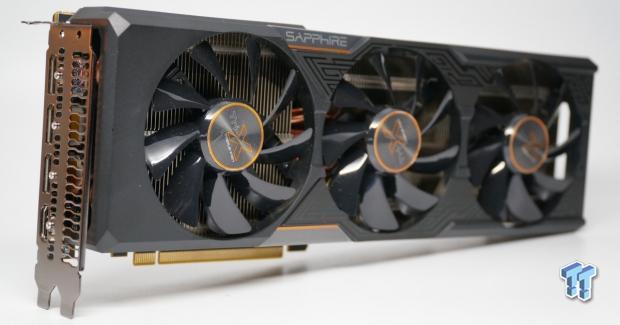
The Bottom Line
Introduction, Quick Specs and Availability & Price
AMD launched its new Radeon R9 Fury X just a couple of weeks ago now, and while we knew that the much bigger, non-watercooled variant in the R9 Fury would launch soon, it feels like no time has passed since then. I would dare say it's because I've been knee-deep in writing Fury X content, with my original review on the single card, then again in CrossFire.
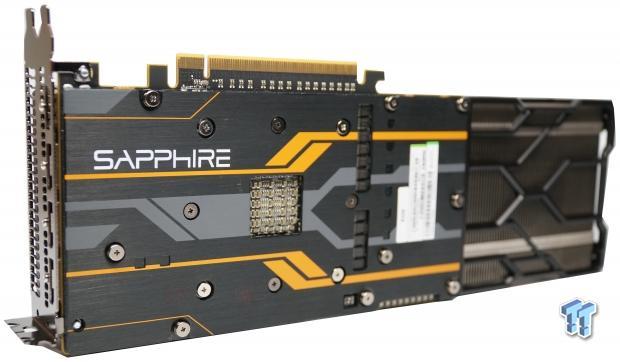
I didn't stop there, as I wanted to push forward with some strenuous testing using a triple 4K monitor setup on a single Fury X at 11,520x2160 and then again on Fury X in CrossFire at 11,520x2160. In a single monitor situation, the Fury X was a good, but not great card. But when thrown into a multi-GPU situation, it kicked some serious ass in single and Eyefinity monitor scenarios.
But the one thing that kept the Fury X from greatness, aside from early performance numbers, was the fact that it had a gigantic radiator. It needs to be installed somewhere in a system, which is annoying. It's not something I would recommend to most people, but an air-cooled R9 Fury? Well, that's a different story I think.
The SAPPHIRE Tri-X R9 Fury is the first R9 Fury that we've received, but we have to know... does it live up to the performance of the Fury X? Not so much. Does it beat the R9 390X? Sure. So where does it find itself? Smack bang in the middle of the R9 390X and R9 Fury X, which is right where AMD needs it to be. Let's get into the formalities before you jump through to the benchmarks.
Quick Specs
SAPPHIRE's Tri-X R9 Fury features the Fury Pro GPU, which means we have High Bandwidth Memory (HBM). There's 56 Compute Units, and 224 TMUs with the GPU itself has 3854 stream processors, with its GPU clocked at 1050MHz. the 4GB of HBM is spread out on a 4096-bit memory bus with 512GB/sec bandwidth.
If we compare this to the AMD Radeon R9 Fury X, which has 4096 stream processors, 64 Compute Units and 256 TMUs, the Fury X is around 10-15% faster on paper, but we'll see later on in the review if this translates into a huge chunk of additional performance.
Availability & Price
Availability of the SAPPHIRE Tri-X R9 Fury will most likely be limited at launch, with the Radeon R9 Fury cards launching on July 14, with no pricing information available at the time of the review.
Packaging & Detailed Look
The Packaging
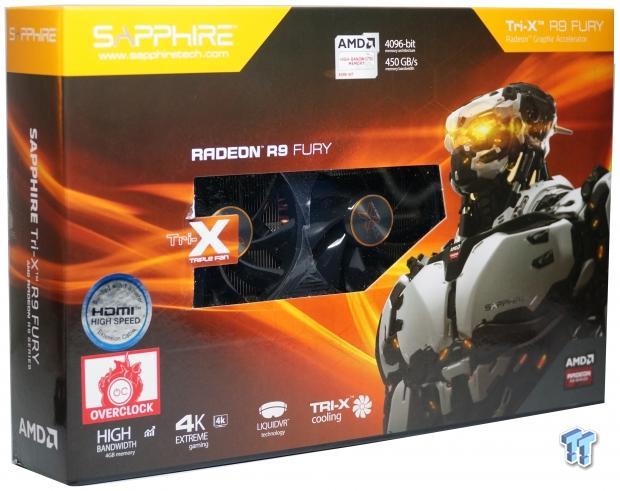
I'm a big fan of SAPPHIRE's packaging for their various Radeon video cards, but the new box for the Tri-X R9 Fury takes the cake. We have a window into the box which shows off that triple-fan Tri-X cooler, as well as some nice box art.
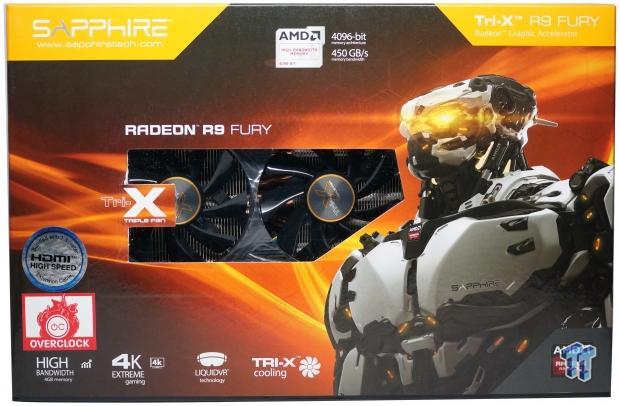
The front of the box has the window showing the Tri-X cooler, while SAPPHIRE makes a big mention of the 4096-bit memory bus and 450GB/sec of memory bandwidth available to the Tri-X R9 Fury. Down the bottom, we see there's 4GB of HBM, the R9 Fury is destined for 4K gaming, with support for Liquid VR thrown into the box.
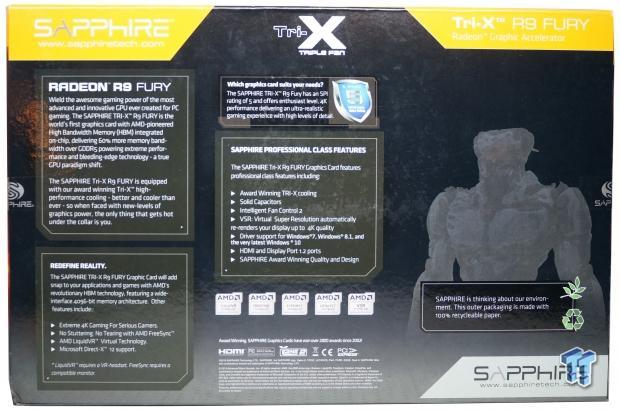
There's not too much going on when the box is flipped around, but we do have SAPPHIRE explaining that the HBM has 60% more memory bandwidth when compared to GDDR5. There's also a reiteration of the features on the back of the card, where we find out the display outputs, Virtual Super Resolution support, Intelligent Fan Control 2, and more.
Detailed Look
Since this is a Tri-X version of the R9 Fury, we know what to expect from SAPPHIRE. But, with the Fiji Pro GPU and HBM requiring some serious cooling - so much so on the Fury X that AMD used a closed-loop liquid cooling system - things are a little different on the Tri-X R9 Fury.
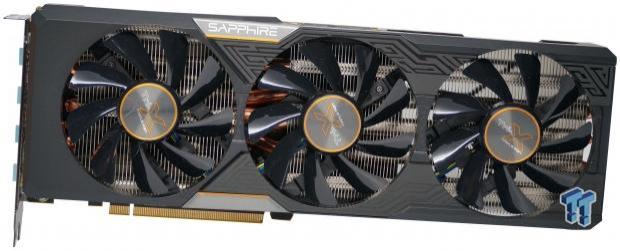
Starting with the front of the SAPPHIRE Tri-X R9 Fury, we have that beautiful triple-fan Tri-X cooler up front and center. But there are some new accents on the Tri-X R9 Fury that have changed since the Tri-X R9 390X, which I really loved.
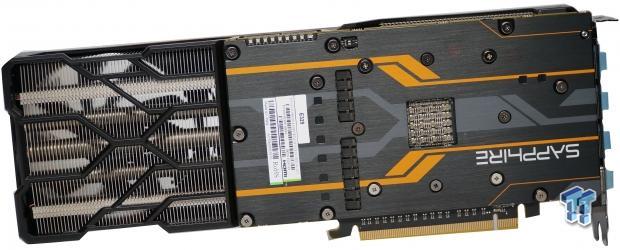
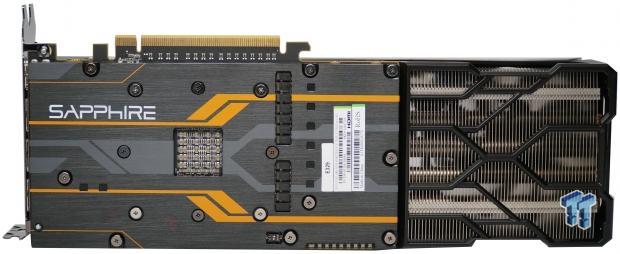
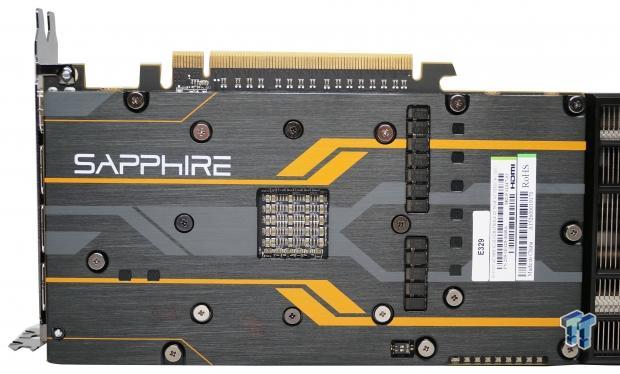
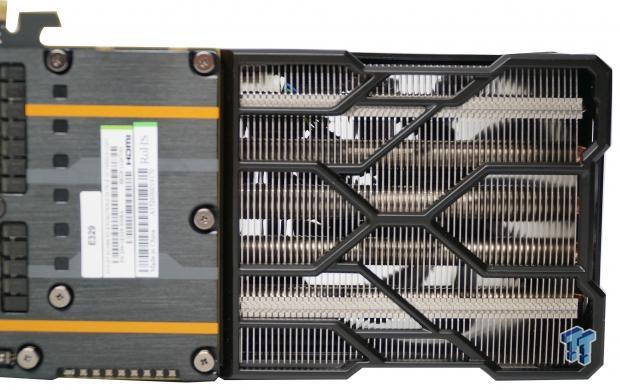
Around back, we can see that new style that SAPPHIRE is going for. Not only that, but we can see how short the PCB is thanks to HBM. To the left, that is all heat sink to keep the Fiji Pro GPU and HBM under cool operating temperatures of less than 75C.
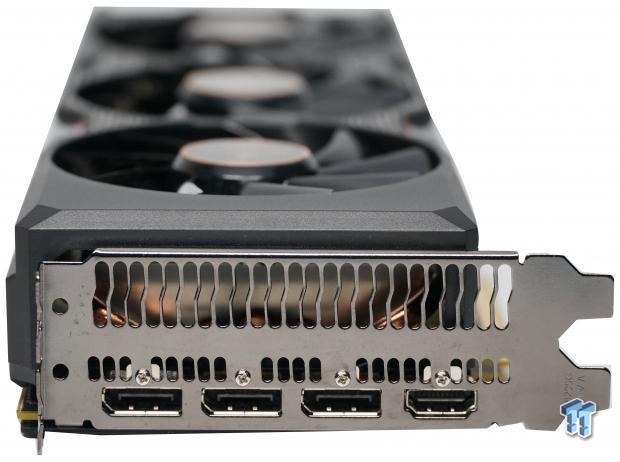
Display output wise we have three DisplayPort 1.2 ports and a single HDMI 1.4a port.

From the bottom of the card, you can get another look at the short PCB. Not only that, but we can see that the card itself is also thicker, and is a 2.5-slot card.

From the top of the card, we can see that massive heat sink array stretching across the entire card. We also have two 8-pin PCIe power connectors.
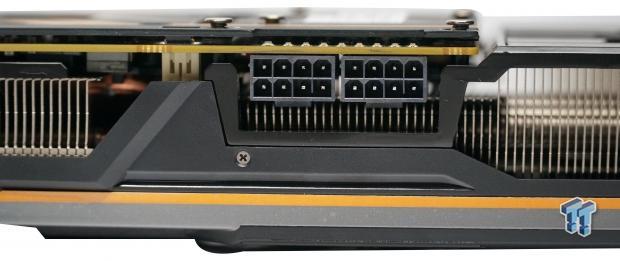
And again, with a closer look at the two 8-pin PCIe power connectors.
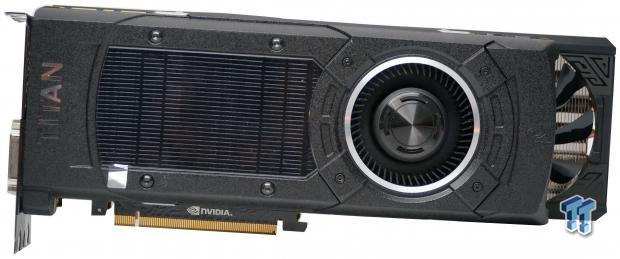
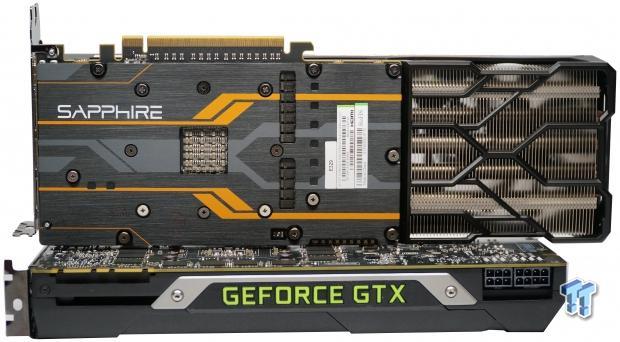
We thought we would show you just how long the SAPPHIRE Tri-X R9 Fury is, so we've put a reference NVIDIA GeForce GTX Titan X in front of it for comparison.
Card Specifications & Cooling Setup
Card Specifications
AMD's product stack has been expanded with the new R9 Fury, so we still have the Fiji architecture here, but the Fiji Pro GPU versus the Fiji XT found in the Fury X. AMD is the only one who is manufacturing Fury X cards, and with the additional CU, TMUs and stream processors, AMD was forced to use liquid cooling to keep it running cool.
But with the watered down R9 Fury, it can be air-cooled, opening up AIB partners like SAPPHIRE to really play with the design of the cooling. As for the specifications, we have 3584 Stream Processors, with a Core Clock of 1050MHz.
There's 4GB of HBM found on the SAPPHIRE Tri-X R9 Fury, the same HBM used on the Fury X, except that it has 450GB/sec memory bandwidth compared to the 512GB/sec found on the Fury X. We have the usual AMD TrueAudio, Liquid VR, CrossFire and other technologies such as Virtual Super Resolution and Frame Rate Limited Control on the SAPPHIRE Tri-X R9 Fury.
Cooling Setup
The Tri-X cooler on the SAPPHIRE Tri-X R9 Fury is the most efficient version of it yet, with three 90mm Aerofoil fans with dual-ball bearing hubs that ensure a long, and very reliable life of your video card. SAPPHIRE has used a multi-heat pipe array on the Tri-X R9 Fury, with 1 x 10mm, 2 x 8mm and 4 x 6mm heat pipes. This should ensure that the card runs relatively cool during operation.
Additionally, SAPPHIRE has used high density stacked cooler fins, a solid copper transfer plate, die cast mounting frame for the PCB and cooler assembly with the cooler assembly extending (far) beyond the PCB for what SAPPHIRE calls "added air circulation".
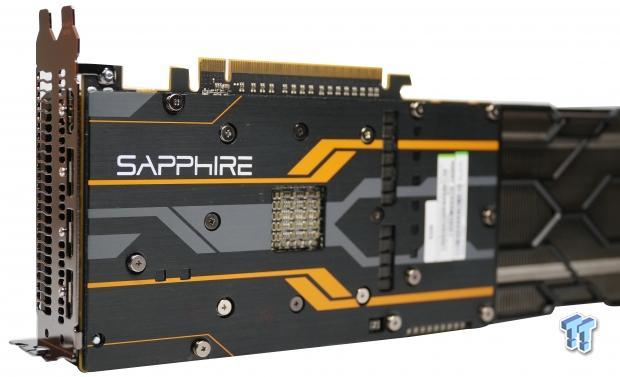
The cooler shroud controls the airflow, and is mounted to the frame, while the thick aluminum backplate is said to reduce the PCB component temperatures. SAPPHIRE has used Intelligent Fan Control (IFCII) which will stop the fans when the load gets low enough on the Tri-X R9 Fury.
Testing Method & Test System Configuration
Testing Method
I've played Battlefield 4 on a 64-player server to provide some real-world performance numbers. I've found this is one of the best ways to provide the most realistic performance numbers, as it involves actual gameplay in a large server that really strains most setups.
For now, I'm going to be using the same suite of benchmarks I've been using on my Tweakipedia articles, which uses a mix of synthetic benchmarks with Futuremark's 3DMark and Unigine Heaven. After that, we have a bunch of titles with built-in benchmarks (which does not represent actual in-game performance) but they are repeatable for you at home to gauge the performance of your PC or GPU.
Over time, I will be adding in new benchmarks and a new section that will concentrate solely on real-time gaming benchmarks. This will take more time per review, as I'll have to invest time into actually physically playing the games, but it'll be worth it in the long run. For now, let's get right into the synthetic benchmarks and see how this ASUS GeForce GTX 980 Matrix Platinum performs.
Test System Configuration
We only recently built our new X99-powered system, something you can read about here. As for the detailed specifications, this is what we're running:
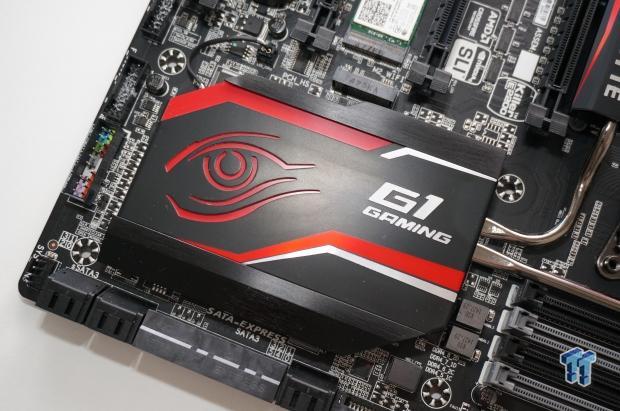
- CPU: Intel Core i7 5820K processor w/Corsair H110 cooler
- Motherboard: GIGABYTE X99 Gaming G1 Wi-Fi
- RAM: 16GB Corsair Vengeance 2666MHz DDR4
- Storage: 240GB SanDisk Extreme II and 480GB SanDisk Extreme II
- Chassis: Lian Li T60 Pit Stop
- PSU: Corsair AX1200i digital PSU
- Software: Windows 7 Ultimate x64
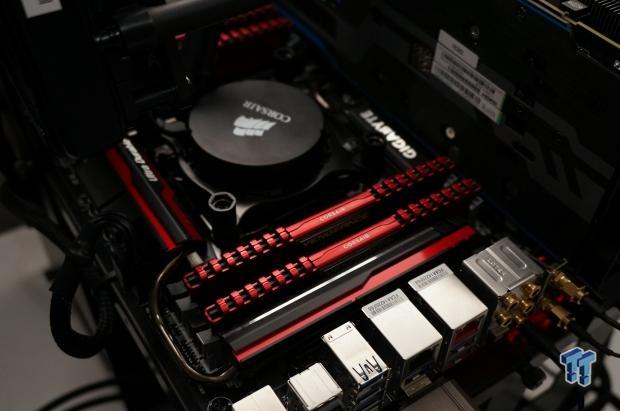
We're running the system at stock CPU speeds, which will provide more of a 'real-world' feel to our benchmarks. Sure, this isn't an i7-5960X at 5GHz, but what person is going to team up an incredibly expensive CPU with a mid-range GPU? Not many.
Our GPU tests are changing, shifting toward more of a real-world feel. But don't worry, we will be doing some crazy balls-to-the-wall tests that will see serious overclocks, Extreme Edition processors, and much more in the coming months. For the most part, we will be doing more real-world testing by teaming up the right processor with the right GPU in its price category.
Benchmarks - Synthetic
3DMark Fire Strike - 1080p
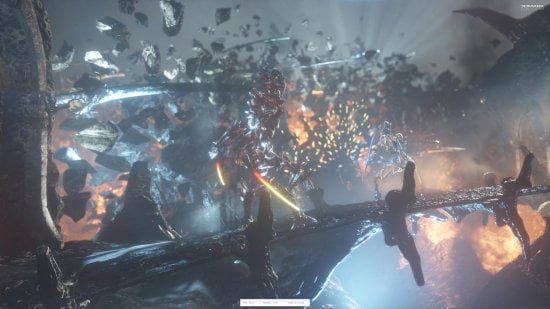
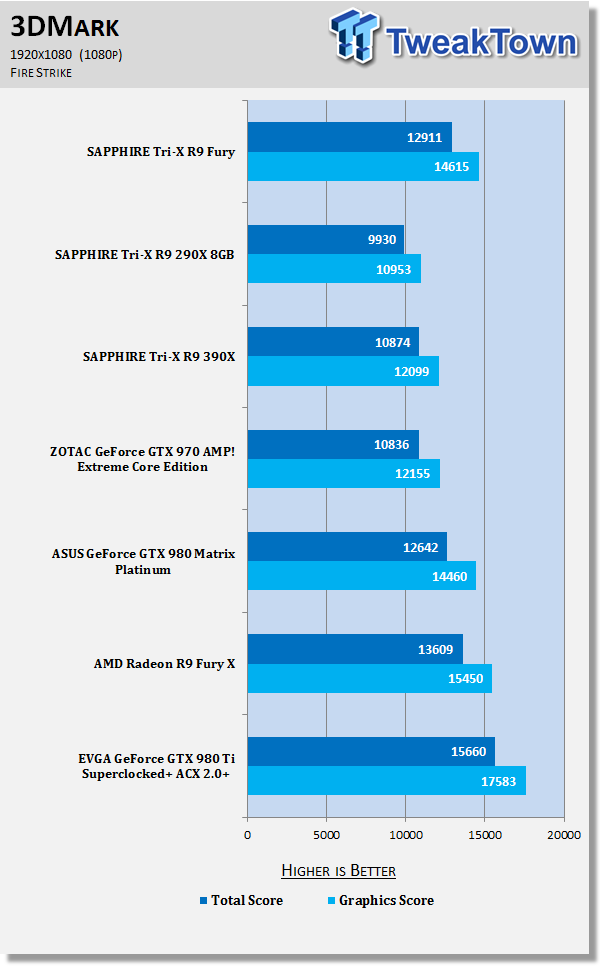
3DMark Fire Strike Extreme - 1440p
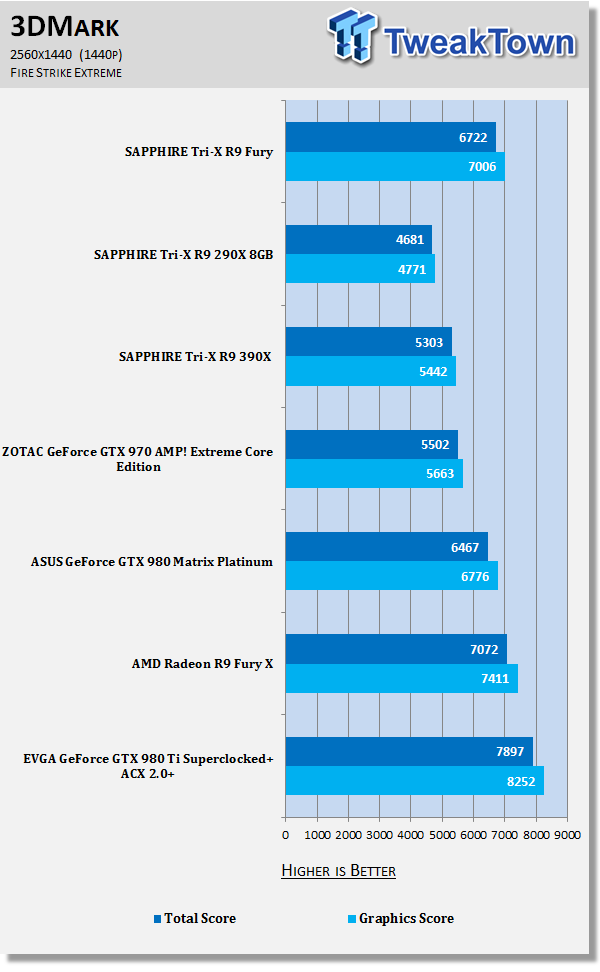
3DMark Fire Strike Ultra - 4K
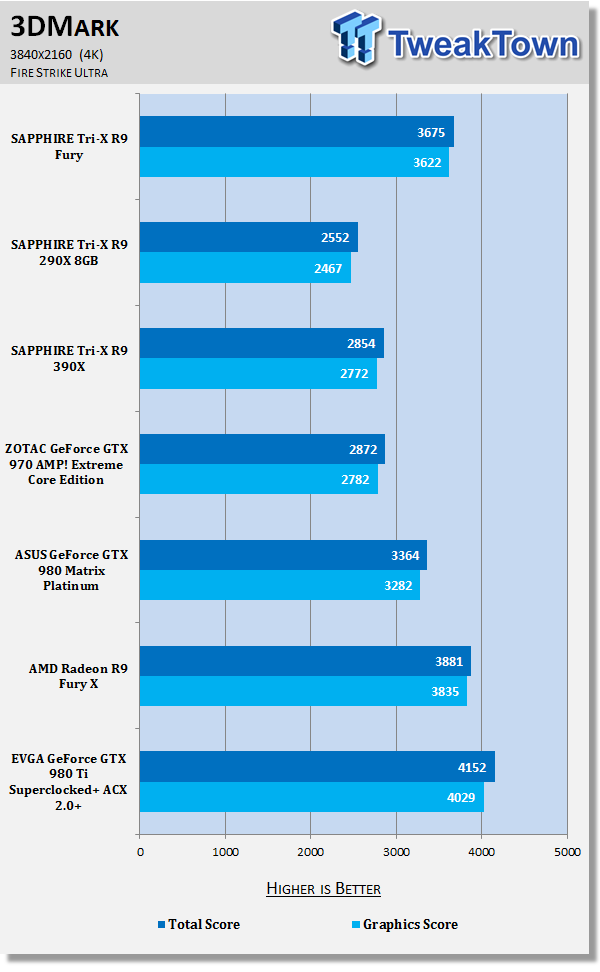
Heaven - 1080p
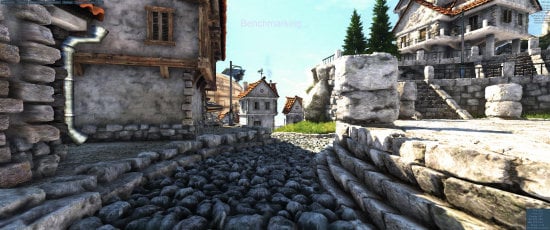
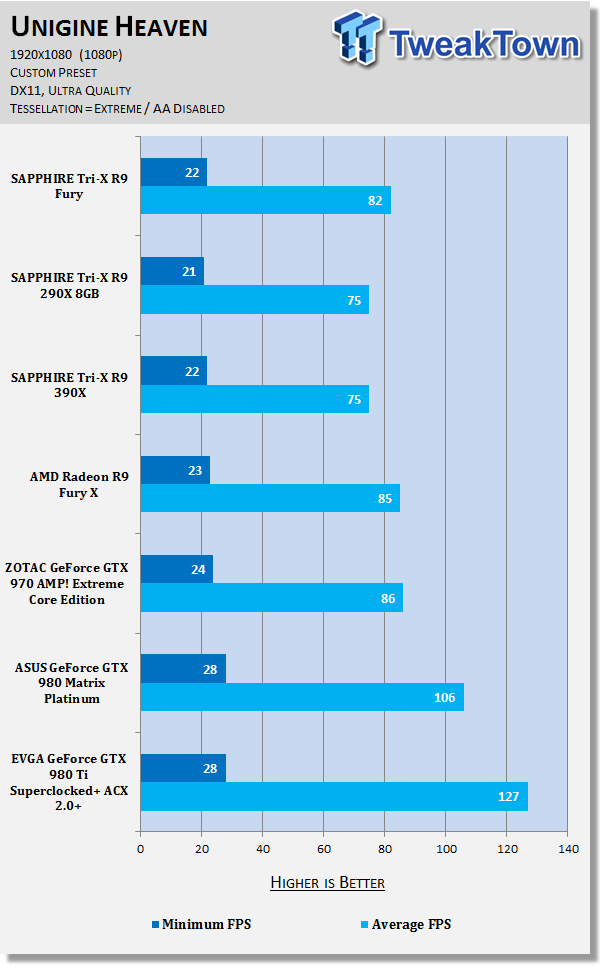
Heaven - 1440p
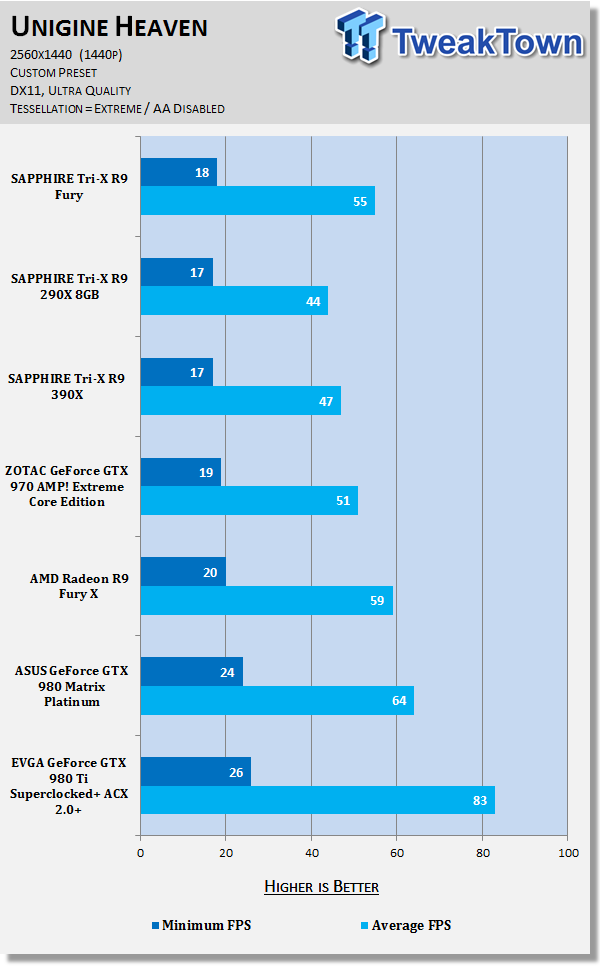
Heaven - 4K
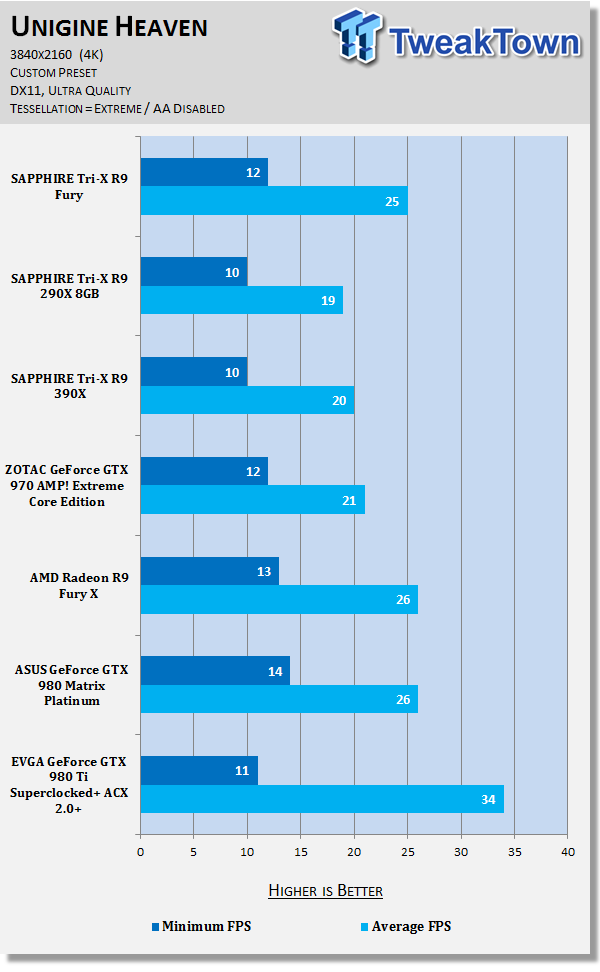
Starting with the 1080p run of 3DMark, the SAPPHIRE Tri-X R9 Fury finds itself close to the Fury X, while it easily throws the Radeon R9 390X to the side. Moving up to the 'Extreme' test at 2560x1440, the Tri-X R9 Fury edges very closely to the Fury X. Cranking up to 4K, the Tri-X R9 Fury X is only barely trailing the Fury X.
Moving onto Heaven, the Tri-X R9 Fury is only 4% slower than the full Fiji XT-based Radeon R9 Fury X at 1080p, while at 1440p the results are very similar, with the SAPPHIRE Tri-X R9 Fury just 7% slower. Right up at 4K, the Tri-X R9 Fury is just 1FPS away from the Fury X, or 4%.
Benchmarks - 1080p
Battlefield 4
This is one game that we did differently, as it does not feature a built-in benchmarking feature. When it comes to Battlefield 4, there are countless ways you can benchmark it. Some find a spot in the single player campaign which is easily repeatable, and use that. For our testing, we've chosen to use a 64-player online multiplayer server for real-time performance statistics.
We joined a 64-player map and played for five minutes using FRAPS, pulling our minimum/average and maximum FPS. We did this for each test, we run the game for 5 minutes at 1080p/1440p and 4K two times each. One time with Medium settings, and another with a custom Ultra preset (disabling AA). It's time consuming, but it gives us a perfect look into true real-world performance.
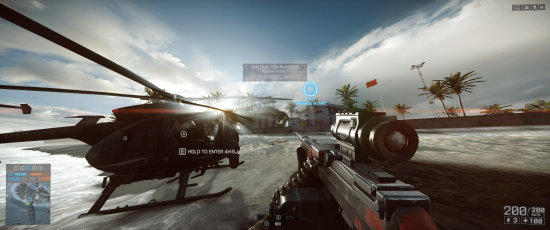
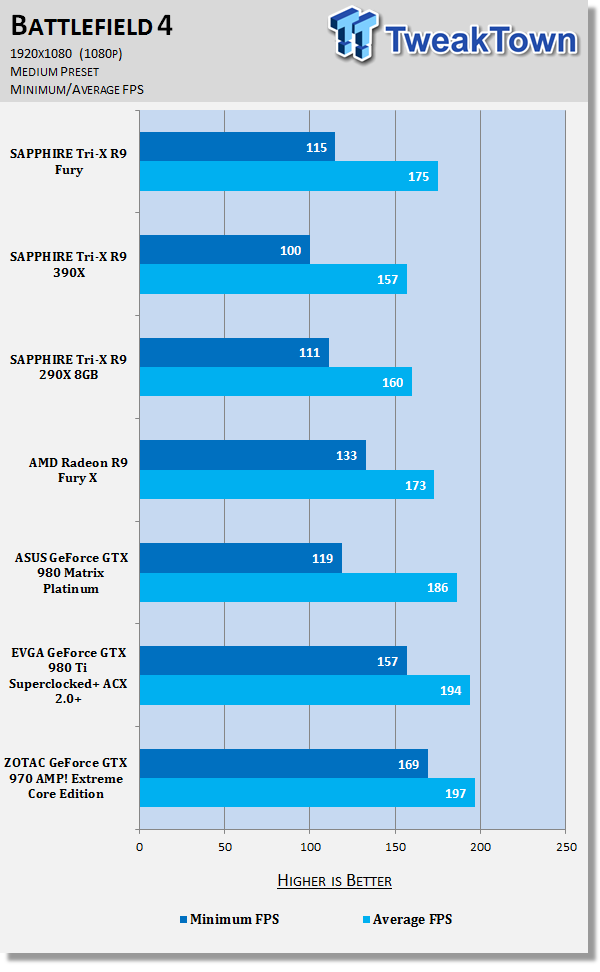
And again, this time with the Ultra preset.
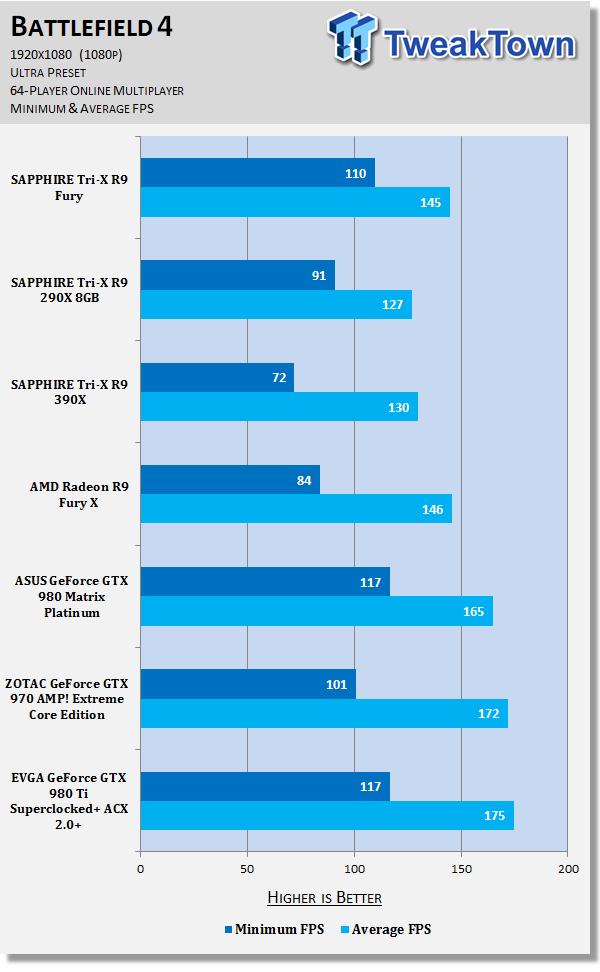
Grand Theft Auto V
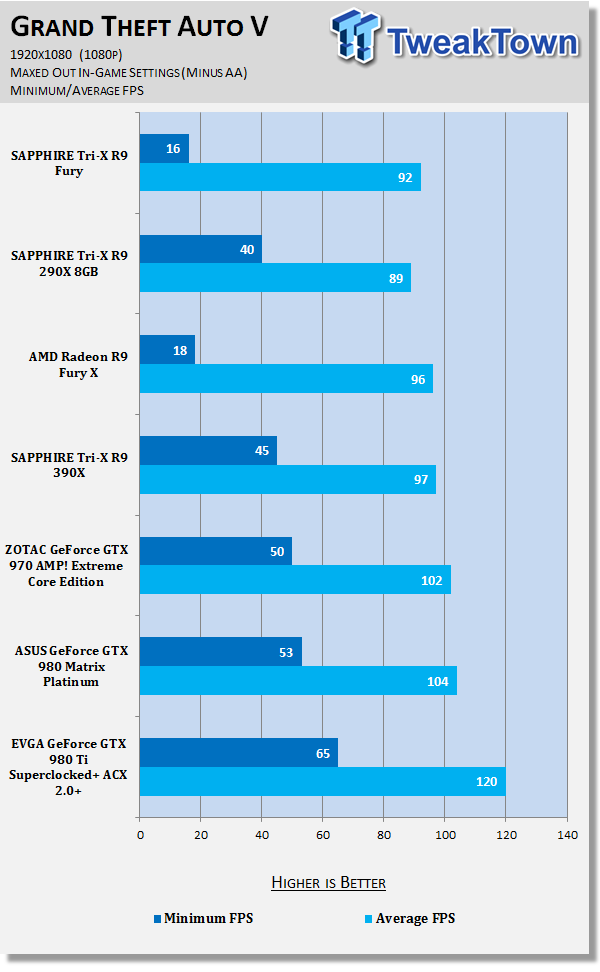
GRID Autosport
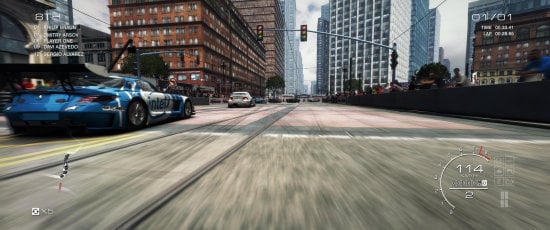
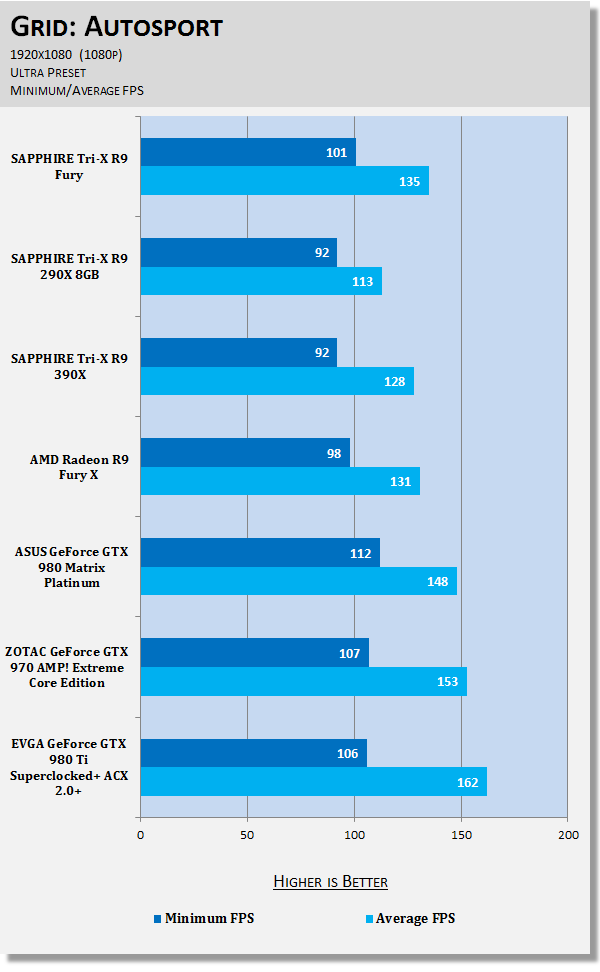
Metro: Last Light
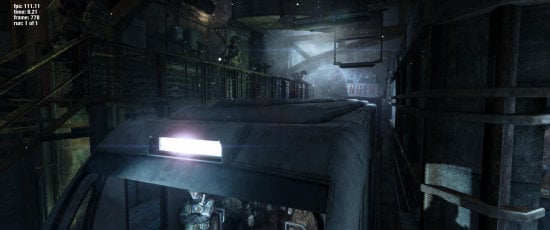
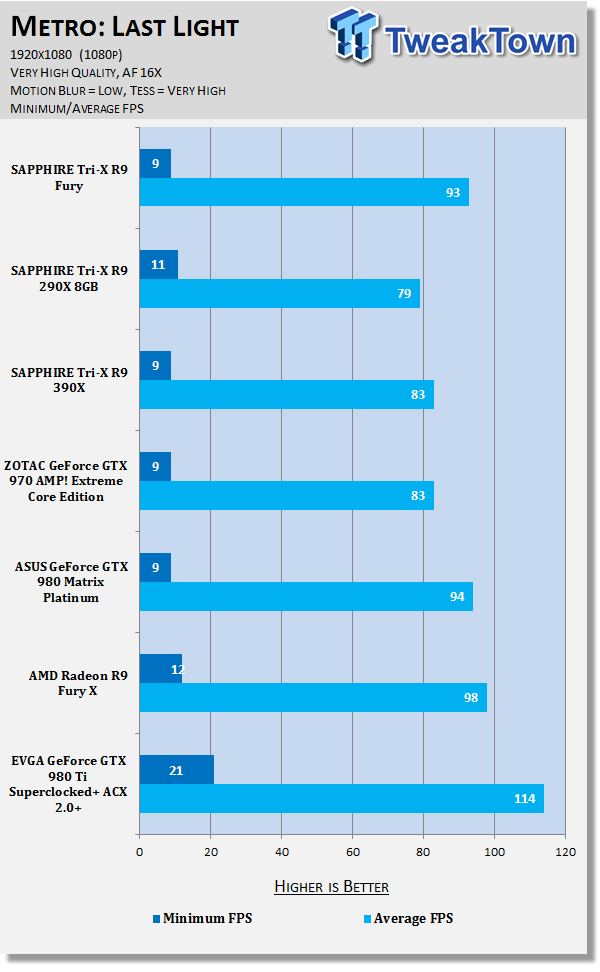
Middle-earth: Shadow of Mordor

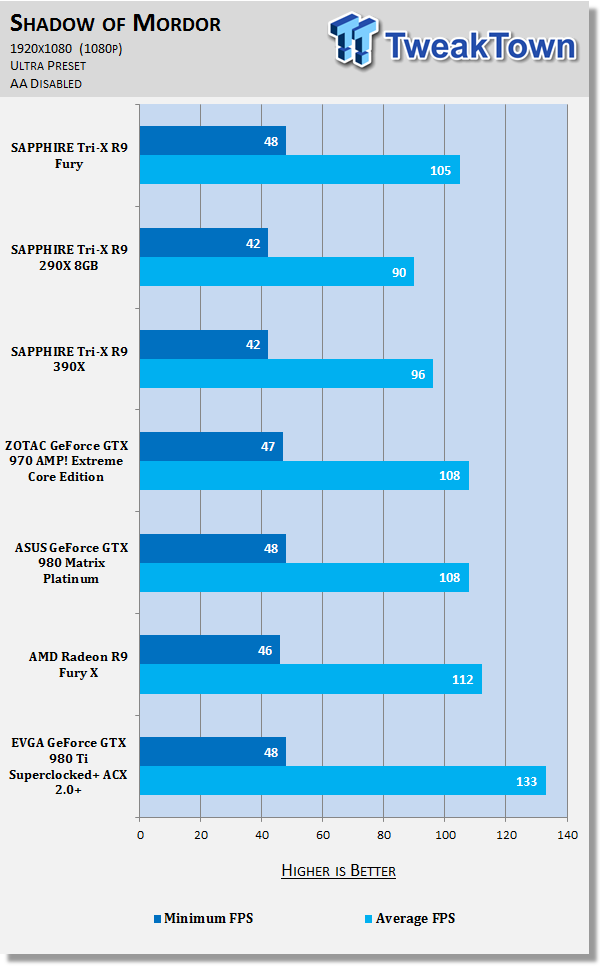
Thief

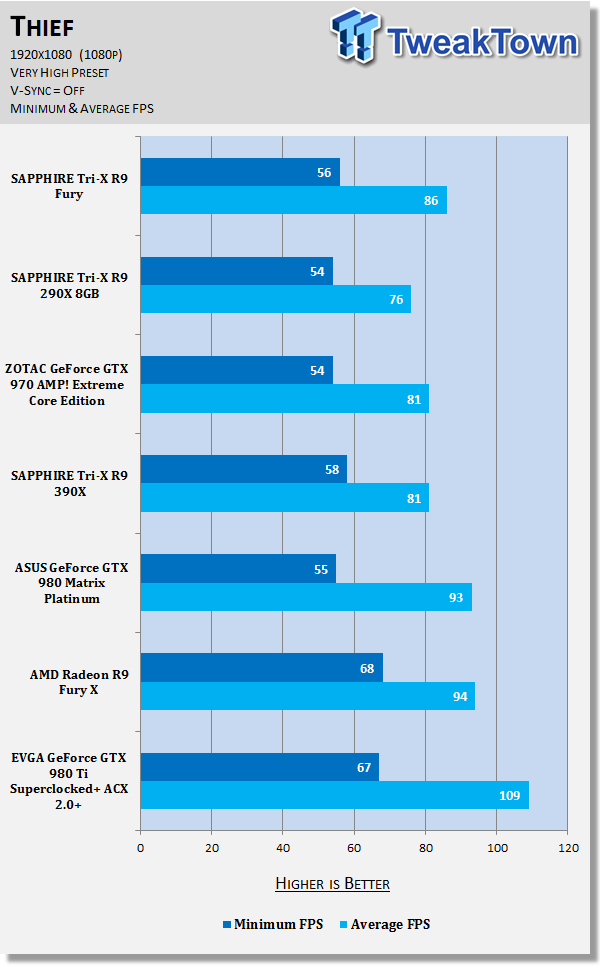
Tomb Raider

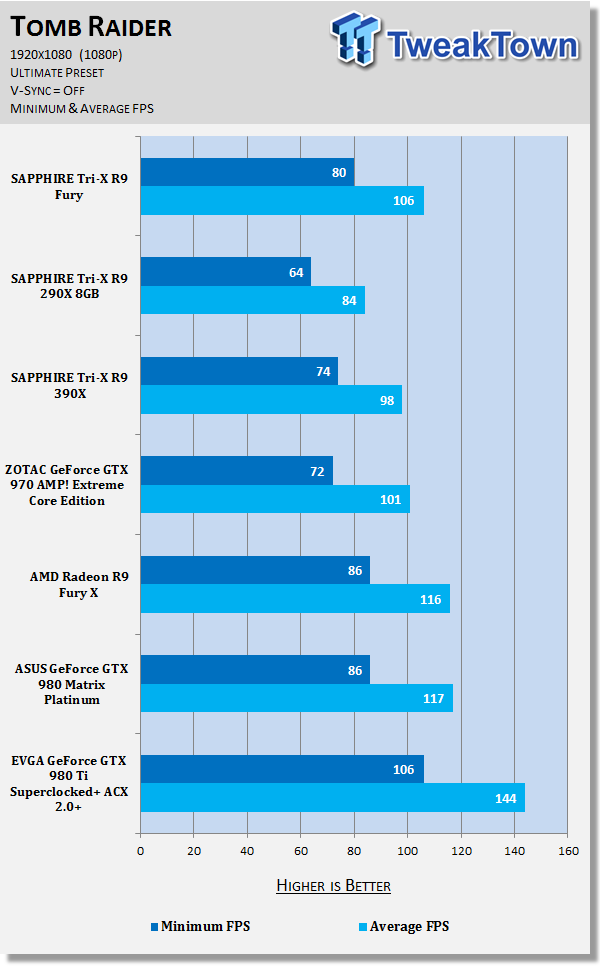
BioShock Infinite

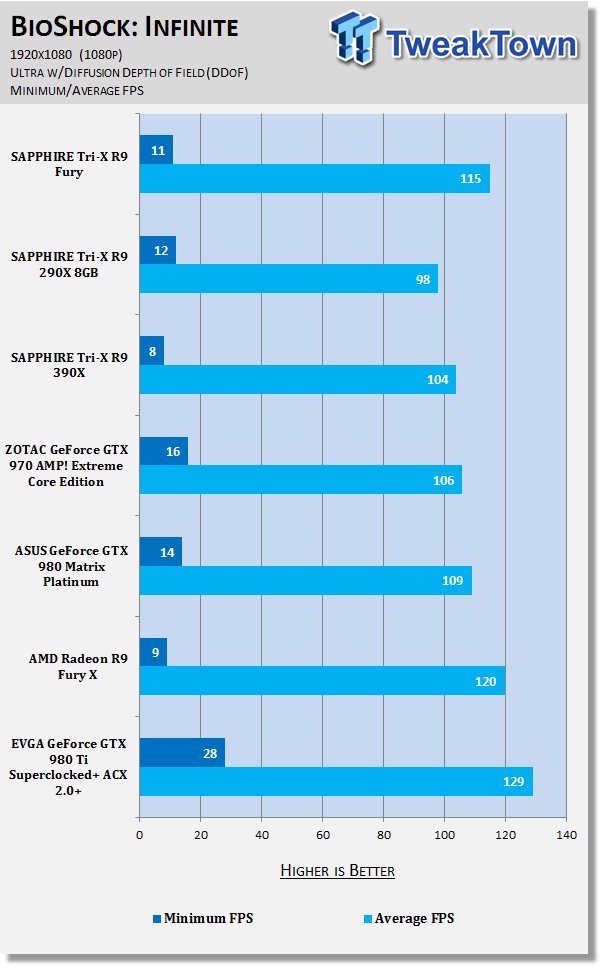
You can find our performance summary of all of our gaming tests later in the review.
Benchmarks - 1440p
Battlefield 4


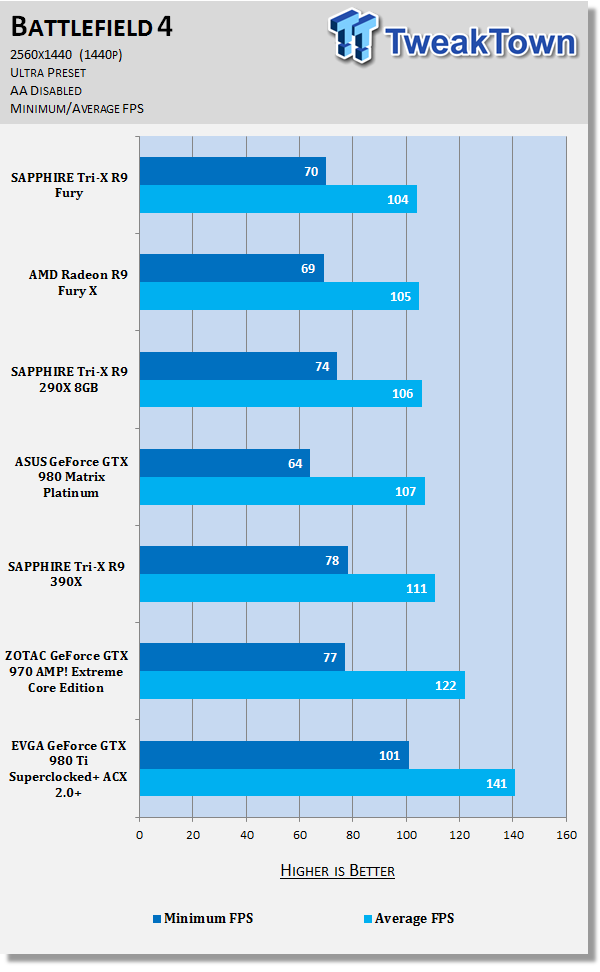
Grand Theft Auto V
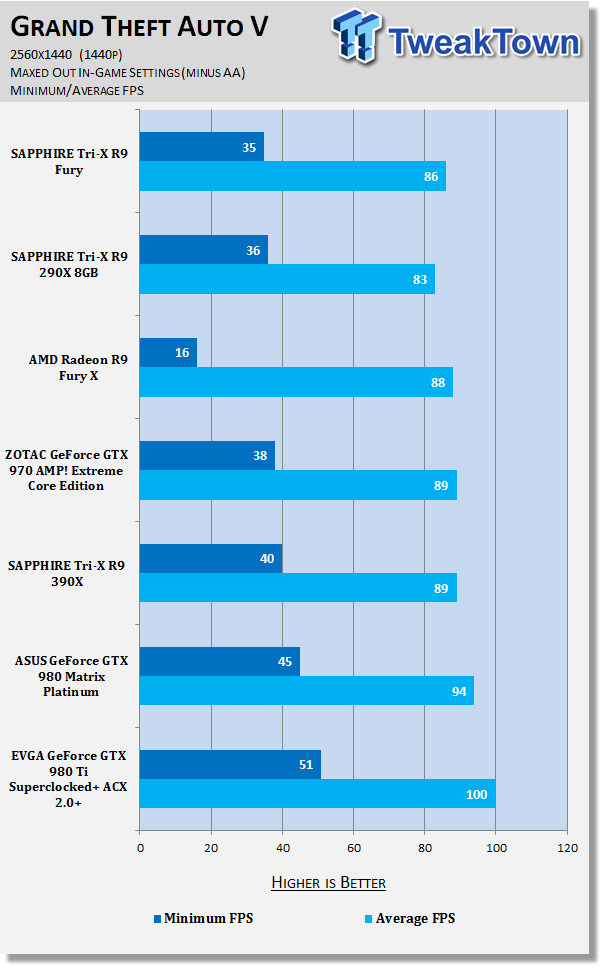
GRID Autosport


Metro: Last Light

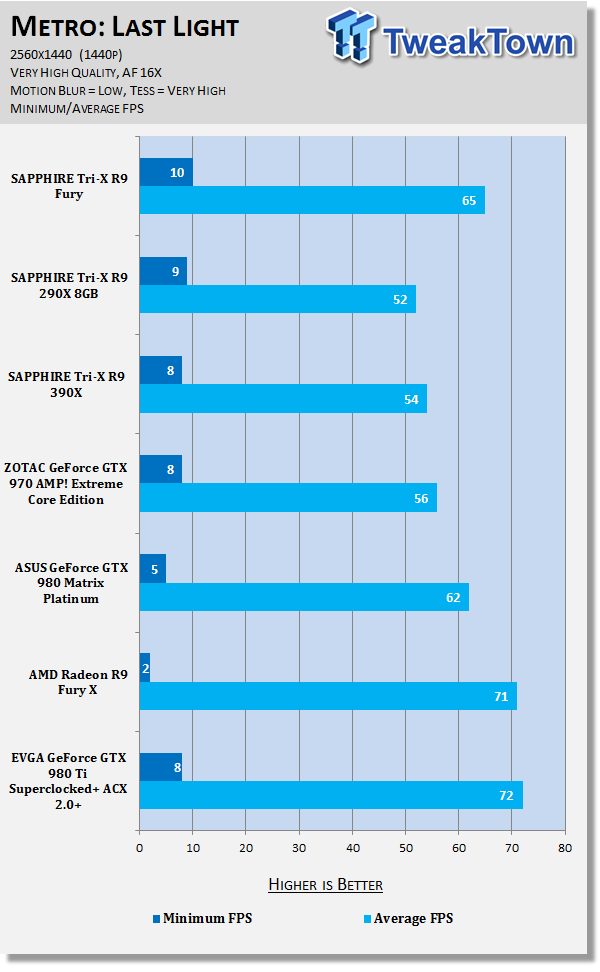
Middle-earth: Shadow of Mordor

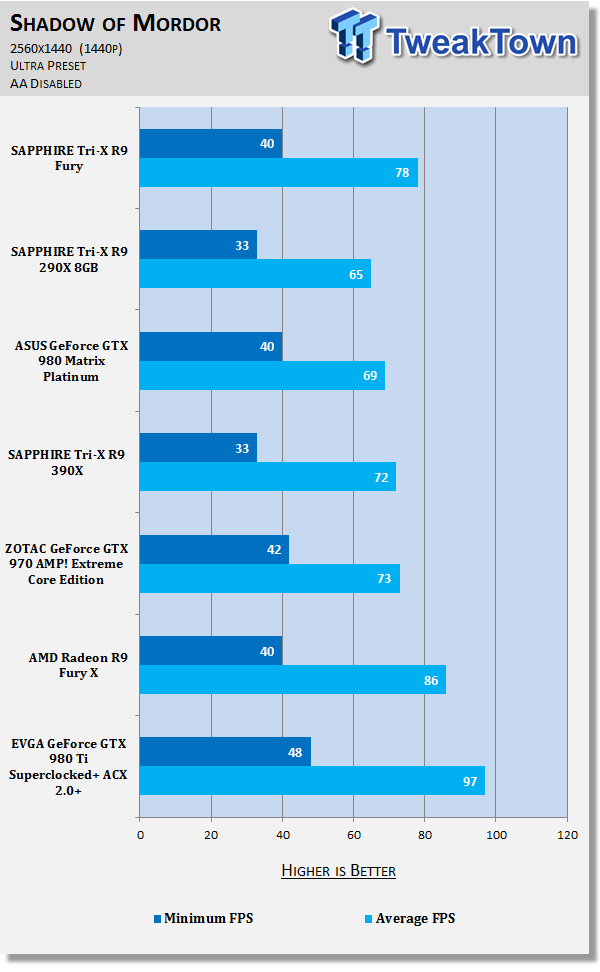
Thief

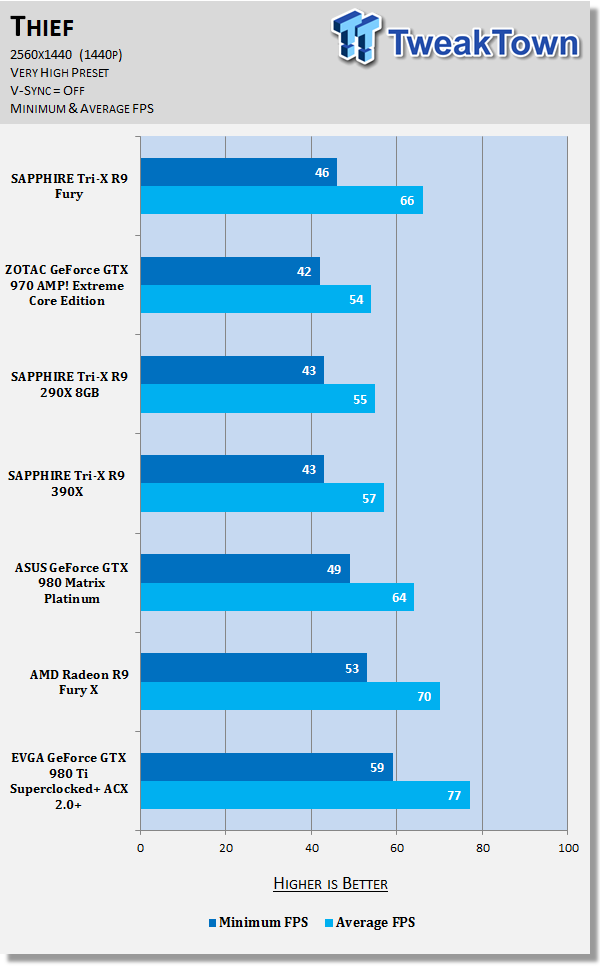
Tomb Raider

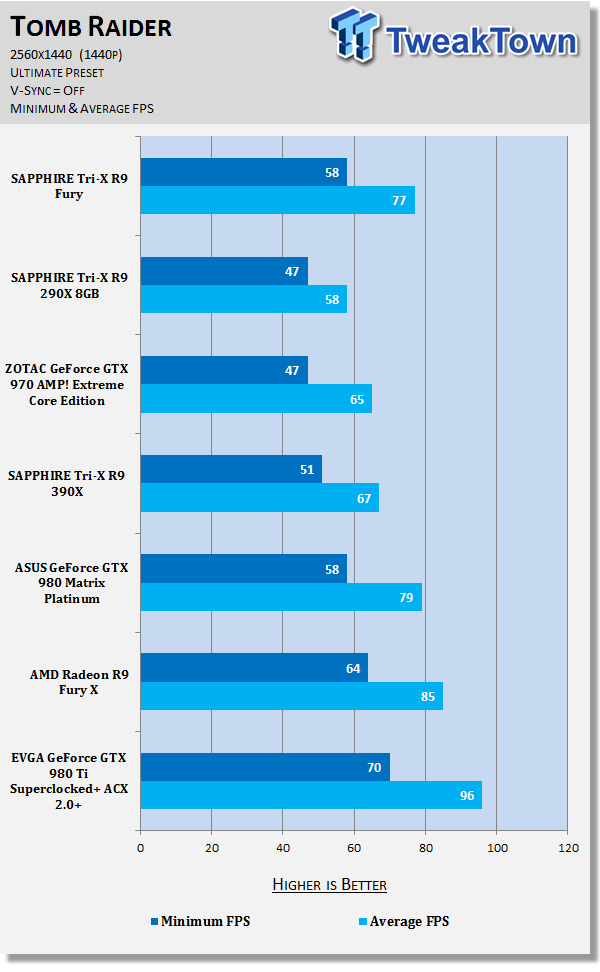
BioShock Infinite


You can find our performance summary of all of our gaming tests later in the review.
Benchmarks - 4K
Battlefield 4


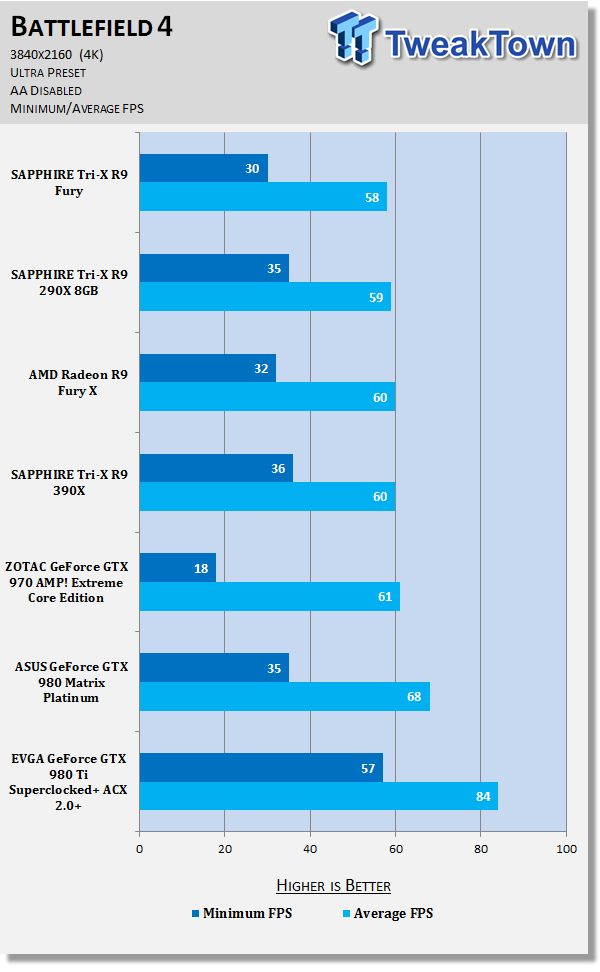
Grand Theft Auto V
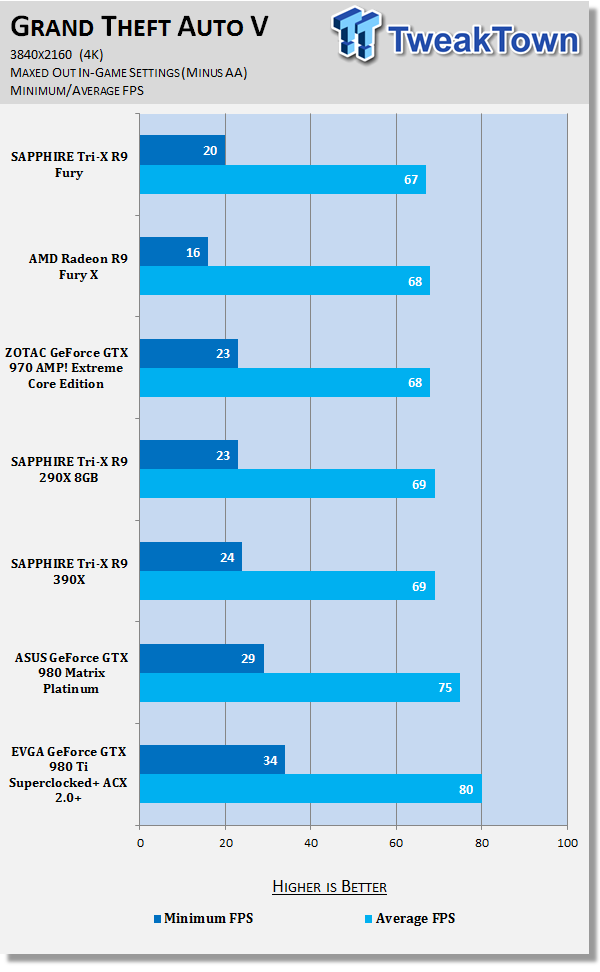
GRID Autosport

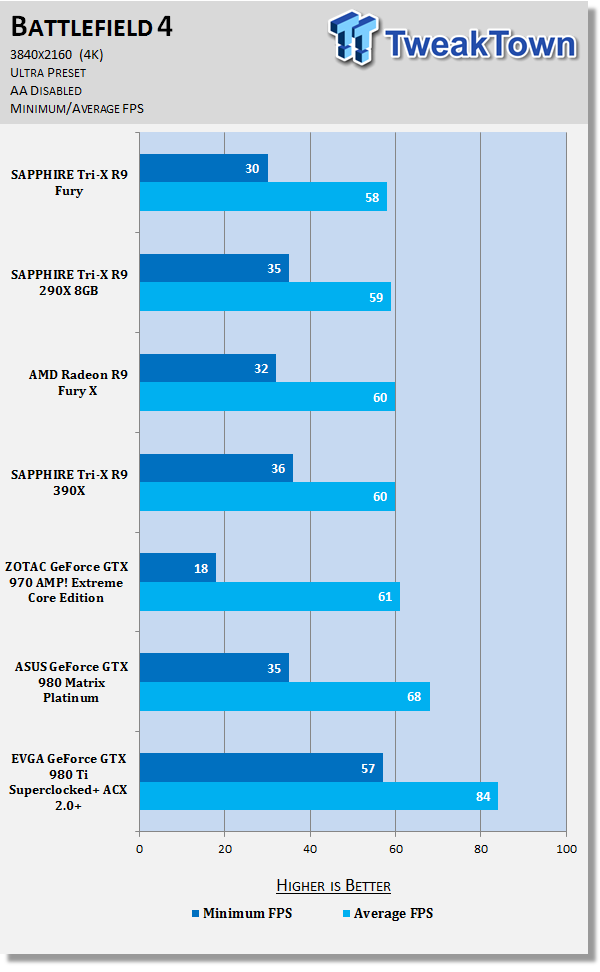
Metro: Last Light

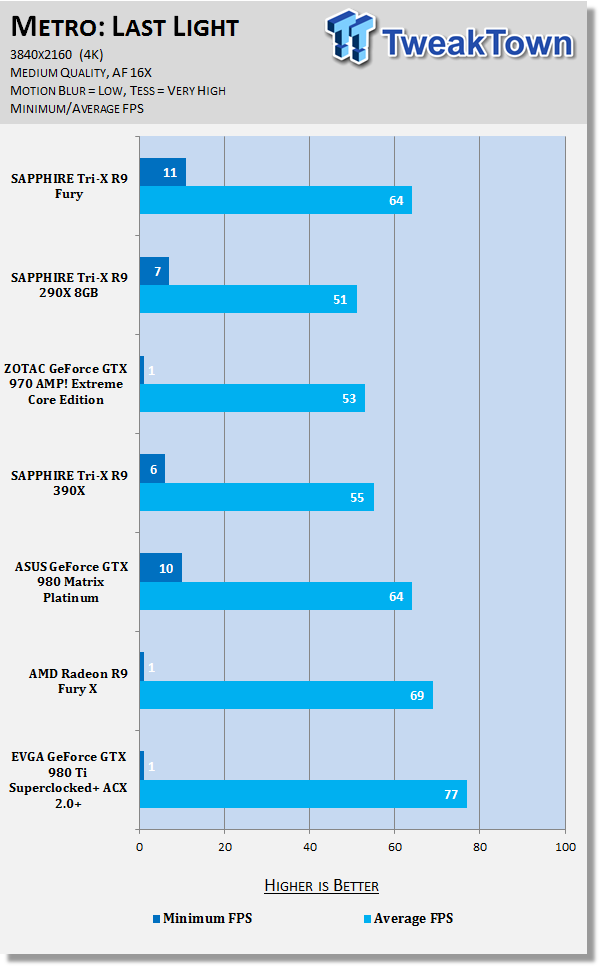
Middle-earth: Shadow of Mordor

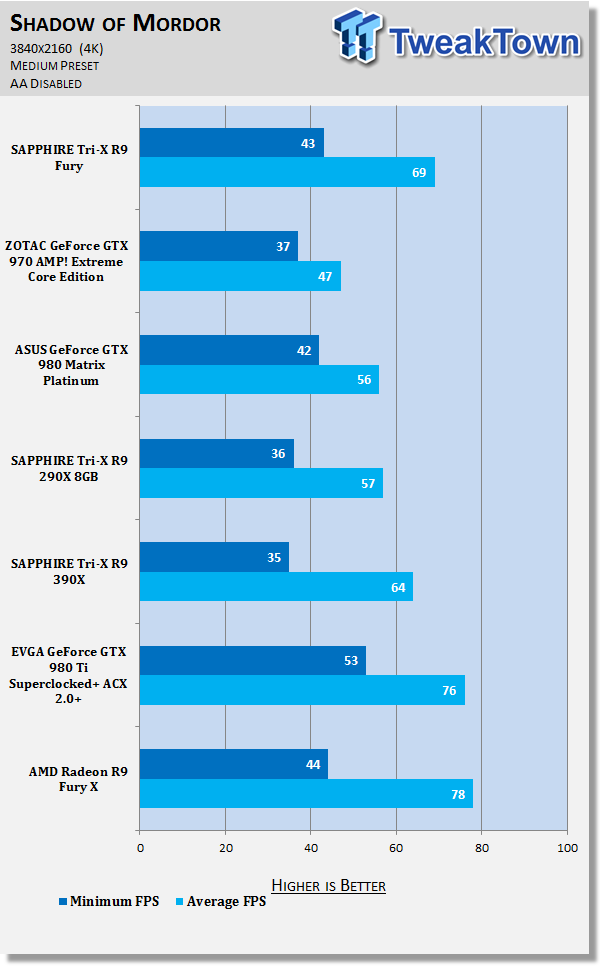
Thief

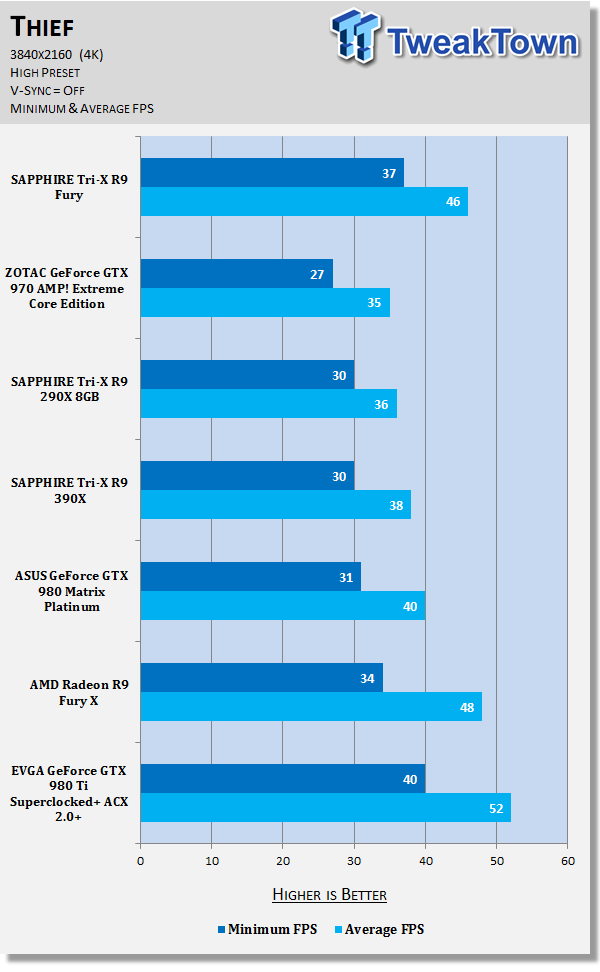
Tomb Raider

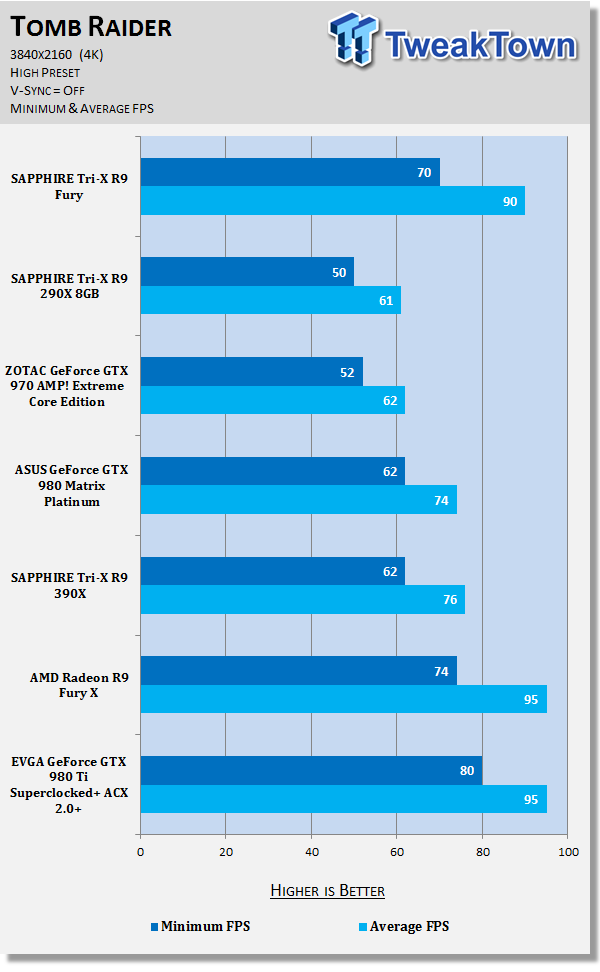
BioShock Infinite

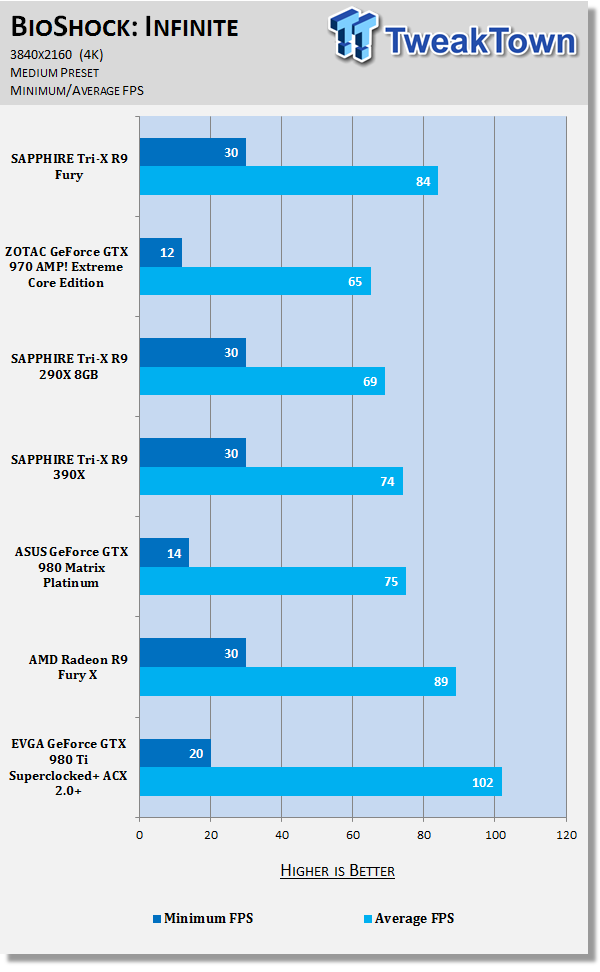
You can find our performance summary of all of our gaming tests later in the review.
Performance Summary
How Does the SAPPHIRE Tri-X R9 Fury Stack Up?
Damn well! It's a lot better than I expected from the cut down Fury X, with it beating the Radeon R9 390X without a problem and it is not too far away from beating the GeForce GTX 980 Ti in most of the games we've tested. Heck, in VRAM intensive titles like Shadow of Mordor, the SAPPHIRE Tri-X R9 Fury actually beats out a heavily overclocked GM204-based card like the ASUS GeForce GTX 980 Matrix Platinum.
Performance at 1080p
As always, we'll kick things off with Battlefield 4 where the SAPPHIRE Tri-X R9 Fury easily beats out the 390X, and is just inches away from the Fury X. Moving onto Metro: Last Light, the Tri-X R9 Fury is only 5% slower than the Fury X.
Shadow of Mordor is an interesting test for memory bandwidth, with the SAPPHIRE Tri-X R9 Fury just 3FPS away from the overclocked GTX 980 Matrix Platinum from ASUS, and 7FPS away from the Fury X, or 7%. Thief is 9% slower on the SAPPHIRE Tri-X R9 Fury when compared to the Fury X, while Tomb Raider is also 9% slower on the Fury.
Performance at 1440p
Battlefield 4 performance was at Fury X levels on the SAPPHIRE Tri-X R9 Fury at 2560x1440, which was great to see. Metro: Last Light had the Tri-X R9 Fury beating the overclocked GTX 980 from ASUS, while it trailed the Fury X by 9%.
Shadow of Mordor performance on the SAPPHIRE Tri-X R9 Fury was great, with 78FPS average at 1440p, resulting in it being 10% slower than the Fury X. But, it still beat the 390X, and overclocked GTX 980. Thief and Tomb Raider saw the Tri-X R9 Fury losing to the Fury X by 6% and 10%, respectively.
Performance at 4K
At the peaks of 3840x2160, the SAPPHIRE Tri-X R9 Fury doesn't bode well with Battlefield 4. I would put this down to early drivers, but we have to wait for some new drivers (which were released as we were wrapping up this review) and to play around with Mantle. For now, 58FPS average is nothing to complain about.
Moving over to Metro: Last Light, the SAPPHIRE Tri-X R9 Fury is 8% slower than the Fury X. Not too bad considering 4K is where all the action is on these HBM-based Fury cards. In Shadow of Mordor, the Tri-X R9 Fury beats out everything but the EVGA GeForce GTX 980 Ti Superclocked+ ACX 2.0+ and the Fury X. Pretty incredible results for SoM.
Lastly, two of our harshest games on our benchmark lineup: Thief and Tomb Raider. Starting with Thief, the SAPPHIRE Tri-X R9 Fury is just 2FPS or 4% from the Fury X. While in Tomb Raider it's just 5% slower than Fury X.
Overclocking, Power Consumption and Sound Testing
Overclocking - Let's See How Far We Can Go
With SAPPHIRE's new Tri-X R9 Fury being based on the Fiji architecture, and thus using HBM, the RAM side of the card is completely locked down. No overclocking can be performed on the HBM whatsoever. The Core can be played with, but we weren't able to reach any conclusive overclocking in our short time with the card.
We did get to around 1090MHz, but the performance benefit was completely negligible. This could've been our sample, or it could've been the drivers that we're using. We will be taking a closer look at overclocking the R9 Fury in the near future.
Power Consumption
Thanks to the use of HBM, the SAPPHIRE Tri-X R9 Fury consumes less power than the Hawaii-based and GDDR5-powered SAPPHIRE Tri-X R9 390X.
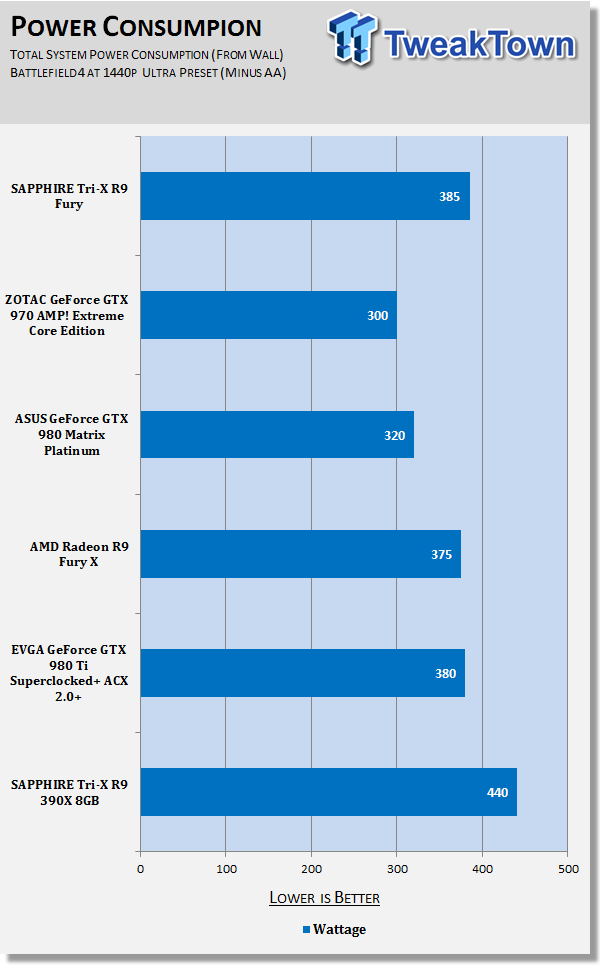
The SAPPHIRE Tri-X R9 Fury consumes around 385W, while the full Fury uses around 10W less, according to our testing. The Tri-X R9 390X from SAPPHIRE consumes 440W for comparison.
Sound Testing
For our testing, we didn't hear a peep out of the SAPPHIRE Tri-X R9 Fury. This is a big turnaround from the Fury X where it has the annoyingly loud pump, which should be fixed before the next batch starts shipping to consumers.
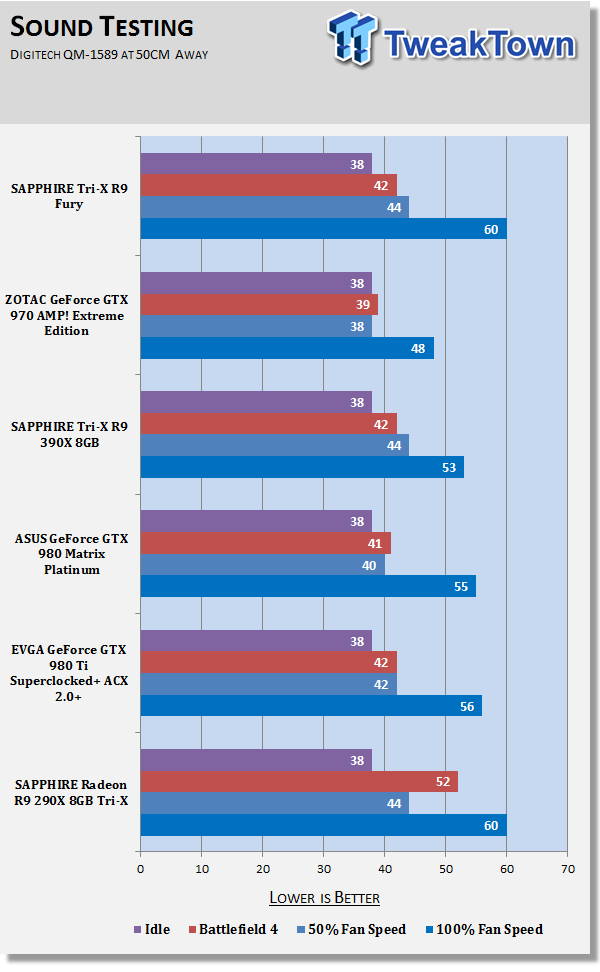
What's Hot, What's Not & Final Thoughts
This is where you can fast forward to the final section of the review, and get a quick recap and points on the SAPPHIRE Tri-X R9 Fury.
What's Hot
Air-cooled Fiji and HBM: This is what the flagship Fury X should've been. While HBM doesn't allow the SAPPHIRE Tri-X R9 Fury to be smaller, it does provide it with some kick ass performance-per-dollar.
Impressive Performance: With performance that beats the R9 390X and is only 5-10% on average away from the Fury X, SAPPHIRE has a kick ass AMD card on its hands with the Tri-X R9 Fury.
SAPPHIRE's Excellent Tri-X Cooling Technology: I've always been a fan of SAPPHIRE's Tri-X cooling technology, and that mixed with HBM and the Fiji Pro core, you're in for a video card that will be silent for 90% of its use. It was only during our sound testing that the card even made a peep.
What's Not
So Much For Shorter Cards: This is why AMD went down the water cooling route with its Fury X, as it ushered in the shortest enthusiast video card we've ever seen. But, it's air-cooled sibling is nearly double the Fury X in length.
Final Thoughts
I'm about as impressed as I thought I would be from the Radeon R9 Fury. In my original review of the Fury X, I said that it was a good card, but it had a few issues that stopped it from being a great card. Well, I think a couple of those issues have been sorted out on the R9 Fury.

One of those big issues is the requirement of the AIO liquid cooler, which I disliked instantly. The R9 Fury doesn't require a liquid cooler, and while temperatures go from the mid 50C mark to around 75C with the R9 Fury, it doesn't matter. This is a card that can be installed into your system without making sure you have a spot to install a radiator.
Secondly, a pair of the SAPPHIRE Tri-X R9 Fury cards in CrossFire would be a super-simple installation, versus the immense hassle it is to position and install two Fury X cards in your system. All of this is gone with the air-cooled R9 Fury.
But the release of the R9 Fury has me enjoying AMD's offering, welcoming it if you're an AMD fan. This is the card you should buy. Not the R9 390X, not the Fury X - but the R9 Fury. SAPPHIRE's Tri-X R9 Fury is a great card, with stylish looks and great performance. I'd love to see what two of these in CrossFire are capable of. If AMD had released the R9 Fury as its flagship and kept the water cooling for its R9 Fury X2 (or whatever it calls it), things would be very different for the company. The R9 Fury is a great release from AMD, it's too bad that the Fury X will get all of the limelight as the Fury is a champion.
SAPPHIRE is actually giving away one of their Tri-X R9 Fury cards, so if you want your chance to win one, check out their website. Not a bad way to market the new card, giving one of the Fiji-powered HBM-based cards away at launch. Enter here!

